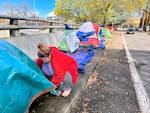Initial numbers from this year’s Multnomah County point-in-time count show an increase in homeless individuals in the county since the last count in 2019.
Multnomah County counted 5,228 people experiencing homelessness on the night of Jan. 26, 2022. On the night of the 2019 Count, a total of 4,015 people were counted as experiencing homelessness,

A young woman secures a tarp on her tent along SW 13th Avenue in Portland, April 4, 2022. Many campers stay in this area because of the close proximity Outside In where they are able to access support services.
Kristyna Wentz-Graff / OPB
A summary of the report was released this week by the Joint Office of Homeless Services, a collaboration between the city of Portland and Multnomah County.
The Joint Office sponsored the point-in-time count, as it’s required by the U.S. Department of Housing and Urban Development. The department allocates funding to address homelessness.
Related: Portland homeless advocates, providers want to house 3,000 people by year’s end
While the outcome of the count does not directly affect funding levels, conducting an accurate tally helps the county remain eligible for more than $25 million in federal funding for homelessness services.
Interim head of the Joint Office, Shannon Singleton, said this year’s count, done during the height of the omicron wave of the COVID-19 pandemic, came with challenges.
“During that time we had folks who had COVID or were in isolation because they had been out with a team that had COVID, so some of those COVID-related impacts were challenging for sure. But I don’t think completely unexpected,” Singleton said.
Multiple teams of volunteers and organizations that assist with the count were unable to participate this year because of COVID. And at least two daytime homeless service centers that were open in 2019, and contributed a significant number of point-in-time county surveys then, remained closed due to COVID. A third site that was open in 2019, St. Francis Dining Hall, is no longer in operation.
Brad Anderson, who has lived in Portland for seven years, volunteered to administer surveys during the count. It was his first time volunteering for the count.
“One of the reasons I did it is I really wanted to understand the statistics,” Anderson said. “When I read these reports in the newspaper, how does that really relate to the situation on the ground?”
Related: Multnomah County Homeless Count Shows More People Living Unsheltered
Anderson did come across a barrier to his work as a volunteer.
“Many people that I interacted with just did not want to fill out the survey.”
Anderson estimates that after interacting with 200-300 people, some of who did not identify as unhoused, only 50 of them completed surveys.
The surveys are offered in multiple languages, and translators were available over the phone. But Singleton admits that getting people to complete surveys is a challenge.
“That’s part of why we really like to work with our outreach partners, because they have relationships out there in the community,” she said. “And if you have that relationship with folks, folks tend to be more willing to sit down and talk with you.”
In addition to the street count, a shelter count is conducted to get an idea how many unhoused people are using available shelters. But the office said even that combined data was not enough to estimate how many people were unsheltered at the time of the count.
“There is no perfect way to do a point in time count,” Singleton said.
To supplement the data, the count also incorporated information from a list of people who had sought out homeless services through various providers, or who had been contacted by a homeless outreach worker.
Singleton says the count will never be a precise measure of how many unhoused people are living in the county.
“Knowing a context of the numbers and what the scope of the problem may be is very important … but we don’t know everything about everybody experiencing homelessness,” Singleton said. “We do know how to treat homelessness.”
Anderson said based on his experience, he assumes there was a major undercount on the number of unhoused people in the county.
“If they were completely unhoused, sleeping in a tent, in a car, and they declined the survey, that would be undercounting,” he said. “And the majority of people that I interacted with declined to participate.”
And Singleton agrees that an undercount is likely. But she said the county gets more from the survey than just numbers.
The U.S. Department of Housing and Urban Development only requires the count to include some specific demographics. Other questions on the survey were chosen by the county and are used to look into the causes and effects of homelessness, and into what action the city and county take.
“Oftentimes we can find things like the trends that we were seeing around racial demographics, for example,” Singleton said. “And really, I think, it sparked some intentional investment in our culturally specific organizations, and also a move to have our mainstream providers begin the work and really push themselves to be culturally responsive.”
Coordination of the count was led by the Regional Research Institute at Portland State University. A full report will be released in the summer.
“When we do more analysis, we’ll know more about if we were successful in getting the information that we need to answer questions to direct our policy decisions moving forward,” Singleton said.
The Joint Office worked to align counting standards with Clackamas County, and it’s working to align its data analysis and reporting with Clackamas and Washington counties.
The agency said this is part of a larger effort to better coordinate services regionally in the wake of the tri-county supportive housing services measure led by Metro and passed by voters in 2020.
2019: Multnomah County homeless count shows more people living unsheltered
